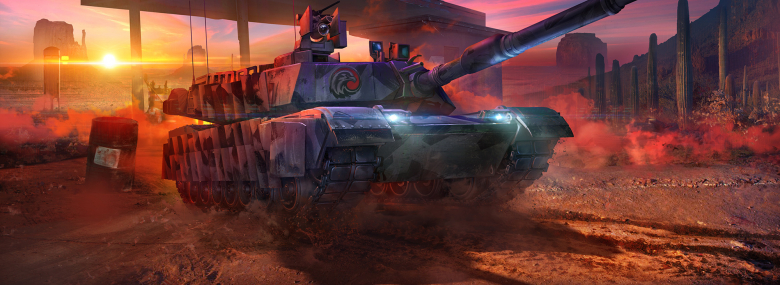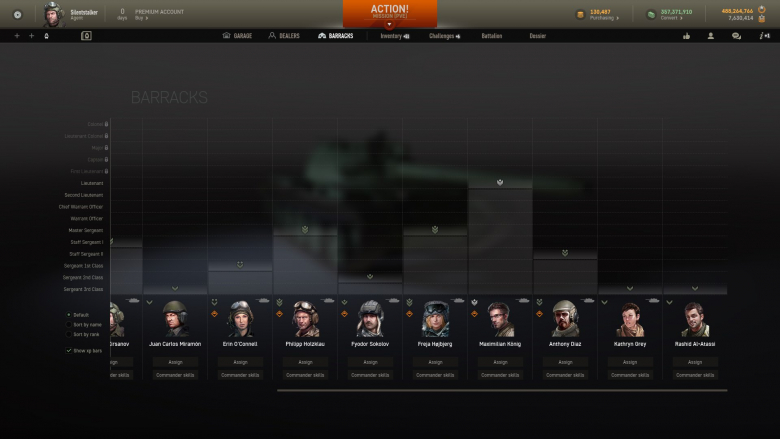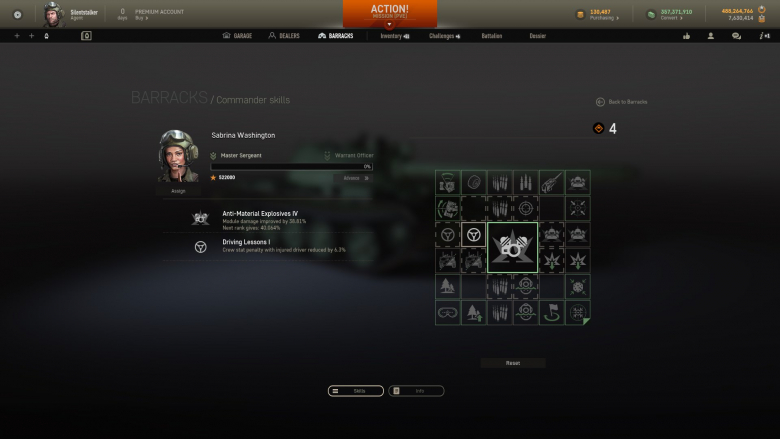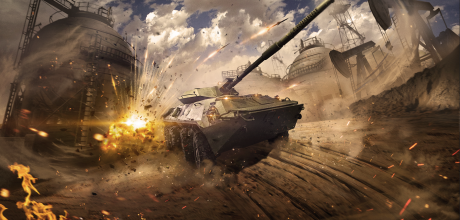
Commanders!
Update 0.22 brought an updated Commander system into Armored Warfare. In this article, we’ll take a look at how the system works in detail.
In Armored Warfare, apart from being available directly in the Garage for every vehicle in the Commander and Crew section of the main screen, your commanders can be managed using the new Barracks Garage window.

Here, all available commanders are laid out next to each other with the bars showing their progression through the ranks. There are 15 commander ranks in the game, ranging from Sergeant Third Class to Colonel – earlier, there were only 5 and the conversion described in a separate section of this Developer Diary.
Commander ranks are gained by collecting Commander Experience (furthermore referred to as Commander XP), which in turn can be gathered by playing vehicles equipped with the specific commanders. The more you play with a commander, the more experienced he or she becomes. The progression speed is roughly equal to vehicle progression and the amount of Commander XP obtained is equal to the Reputation obtained from battle, including bonuses such as Premium Time.
Each Rank (often referred to as “level”) comes with a skill point. Skill points can be invested on each commander’s detailed screen into additional bonuses called Skills. Let’s take a look at them a bit closer before we explain the details of the new progression system.
Skills
Skills are organized into Skill Fields of various shapes and sizes. Basic commanders like Viktor Kirsanov usually have just a simple square, while more advanced commanders, like Kathryn Grey, have more elaborate shapes woven into the Skill Field. The basic principle of skill point assignment is that players can only assign these to skills that are adjacent to those already unlocked. Additionally, this progression is only possible horizontally or vertically, not diagonally. In other words, if you have a skill unlocked, you can unlock another skill that’s to the left from the already unlocked one, to the right, below or above.

The starting point for each commander is called Basic Skill, while the rest of the Skill Field space is occupied by either skill slots or empty spaces. The goal is to configure your skills by making a path through the field the way you find best for your play style.
Basic Skill is the initial progression point each commander has. It does not have to be unlocked and becomes more powerful with each rank the commander achieves.
Skills are represented by rectangular icons on the Skill Field. They offer a wide variety of bonuses, some of them being unique to a specific commander. The skills define the style of each commander – Philipp Holzklau is, for example, a commander very suitable for Main Battle Tanks and his skills reflect this fact, focusing on repair speed, crew resilience and other bonuses useful to MBTs.
There are three quality tiers of skills:
- Tier 1 with grey icons offers the smallest bonuses
- Tier 2 with green icons offers medium bonuses
- Tier 3 with golden icons offers the best bonuses
When choosing which skill to unlock, their quality often plays a major role – is it better to unlock two smaller skills you need, or focus on spending the skill points to get to the desired Tier 3 skill as fast as possible? The decision is yours, commander. Please note, however, that not all commanders have the skills of all tiers – some introductory commanders such as Philipp Holzklau only have Tier 1 and Tier 2 skills, but they have more of them.
Skills also come in two types – permanent and conditional. Conditional skills appear with a “folded corner” (a triangle) in lower right corner.
- Permanent skills offer bonuses that are always active (such as a hitpoint bonus)
- Conditional skills offer bonuses that are usually better, but only activate under certain circumstances (for example, a rate of fire bonus that is active only when the vehicle hitpoints drop under a certain threshold)
Choosing which skills are the most beneficial for you is a part of the commander configuration – some conditional skills, for example those that activate with damage taken, are extremely useful for players who prefer aggressive play style.
Please note that a commander can have more fields with identical skills in his Skill Field:
- When more than one such skill is selected, these skills stack (they accumulate, not multiply each other)
- The same skill can also appear with multiple Tiers in one Skill Field (for example, a commander having a Tier 1 and a Tier 3 skill that both increase vehicle camouflage), these also stack with each other
The last type of skill fields is empty fields – those often lie in the quickest path to the best (Tier 3) skills. As their name suggests, they can be unlocked but they do not offer any bonuses. It’s your choice whether to take the longer path leading over lesser skills, or take the quick path to the desired Tier 3 skill.
Commander Options
Apart from the Skill Field, other commander options are also available on the Commander Screen.

These include, from above:
- Commander Portrait and Name
- Commander Progress Bar and Rank (with the amount of XP gathered)
- Assign button under the portrait (used to select the vehicles for this commander)
- Advance button under the bar (used to convert Global Reputation to Commander XP)
- List of active Skills
- Reset button under the Skill Field (used to reset that commander’s progress either for free with an XP penalty, for Credits with lower penalty or for Gold with no penalty)
Please note that commander progress can be reset at any time – fixing a wrong Skill selection is just one click away.
System of Progression
As we mentioned already, the Commanders in Armored Warfare progress by accumulating Commander XP from battles. Commanders start with the first rank (Third Sergeant) and there are 15 ranks in total (all the way up to Colonel).
The rank promotion is not automatic – when a commander gathers enough XP, he has to be manually promoted in his Commander window. Until Rank 10 (Lieutenant), all commanders can progress independently –after gathering enough XP for the next rank (either by playing or converting Global Reputation to Commander XP), you simply can promote each commander rank by rank.
When they reach Rank 10, however, a new system called Chain of Command Progression comes into play. Contrary to the belief of some people, a chain of command is not the chain soldiers get beaten with to know who’s in command.
Very simply put – by the time you reach Rank 10, you should select your “main” commander you want to reach Rank 15 with. Just like in the army, not everyone can be a colonel – a chain of command of your Private Military Company has to be forged.

What this means is that while all your commanders can reach the rank of Lieutenant (Rank 10), you cannot progress through the following five ranks while leaving a certain rank empty.
In practice, what this means, in order to have one of your commanders as a Colonel (top Rank, Rank 15), you have to have:
- One Lieutenant Colonel (Rank 14)
- One Major (Rank 13)
- One Captain (Rank 12)
- One First Lieutenant (Rank 11).
In other words, to obtain one Rank 15 commander, what you need is to do this:
- Train six commanders to Lieutenant (Rank 10), one stays as such
- First commander needs to be trained to Rank 11 (First Lieutenant)
- Second commander needs to be trained to Rank 12 (Captain)
- Third commander needs to be trained to Rank 13 (Major)
- Fourth commander needs to be trained to Rank 14 (Lieutenant Colonel)
- Fifth commander can then be trained to Rank 15 (Colonel)
As long as this chain of command is kept, commanders can progress – you can of course assemble the abovementioned command structure in any order you want, as long as the ranks follow one another. You can for example:
- Train all six commanders at once
- Train two commanders to Lieutenant (Rank 10), promote one to First Lieutenant and then return to the third commander, who can not only be trained to Rank 10 freely, but can advance to Rank 12
And so on. The choice is, once again, yours.
Please note that achieving a Rank 15 commander is not a mandatory task – Rank 10 commanders are considered to be very powerful indeed. Rather than a must-have, it is a long-term goal that will give you an extra edge on the battlefield.
Update 0.21 commander conversion to the new system
The conversion of previously used commanders to the new system is not based on how much Commander XP you previously had, but on levels.
Players receive a commander of equal level than they had before with the levels being rounded up to the level above – if you had a Level 3 commander with any XP above Level 3, you will receive a Rank 4 (Level 4) commander. Now that the new commander level is established, players will receive enough Commander XP to fit the level in the new system, which is:
- Level 1: 0
- Level 2: 5 000
- Level 3: 22 000
- Level 4: 77 000
- Level 5: 222 000
- Level 6: 522 000
Old Level 5 commanders are treated a bit differently. If a player had a commander that achieved Level 5 and some experience accumulated (the commander was “maxed out”), he will receive a Rank 6 commander instead of Rank 5, as such:
- If the commander had less than 522 000 XP accumulated in total, the commander receives 522,000 XP ("stock" Rank 6)
- If the commander had more XP than 522,000 accumulated by the time Update 0.22 was introduced, he will receive that amount (up to 999,999 XP)
Basically, moderately experienced old Level 5 commanders with some battles accumulated will become stock Level 6 commanders, while very experienced commanders (that you played many battles with) will receive up to 999,999 XP based on what you earned. That is not enough to reach level 7, but enough to give you some head start. You cannot, however, receive a commander of higher rank than 6 using this system.
Also, please note that the User Interface XP counter was changed from overall gathered XP to current level XP.

As a practical example, on the image above, the commander looks like it has 477k XP, but that's from Rank 6 to Rank 7, which means that he in fact has 522k (Rank 6 value from the table above) + 477k (displayed value) = 999k XP in total.
Conclusion
This new system is easy to learn but difficult to master. Experiment with various skill builds, find the commanders that suit you the most and expect more commanders to be introduced in the future.
We’ll see you on the battlefield!








